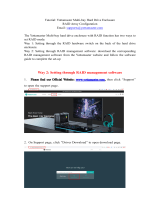
Contents
Chapter 1. Introduction . . . . . . . . . 1
Solution package contents . . . . . . . . . . . 1
Features. . . . . . . . . . . . . . . . . . . 1
Specifications . . . . . . . . . . . . . . . . 3
Upgrade existing NeXtScale nx360 M5 to
ThinkSystem SD650 . . . . . . . . . . . . 7
Management options. . . . . . . . . . . . . . 7
Chapter 2. Solution components . . . 15
Front view . . . . . . . . . . . . . . . . . 17
Enclosure . . . . . . . . . . . . . . . 17
Tray . . . . . . . . . . . . . . . . . 17
Rear view . . . . . . . . . . . . . . . . . 18
Fan power control (FPC) module . . . . . . 19
Power supplies . . . . . . . . . . . . . 19
Internal cable routing. . . . . . . . . . . . . 21
2.5-inch drive models. . . . . . . . . . . 21
Internal Faceplate Transition (IFT) adapter. . . 21
Parts list. . . . . . . . . . . . . . . . . . 22
Power cords . . . . . . . . . . . . . . 27
Chapter 3. Solution hardware
setup . . . . . . . . . . . . . . . . . . 29
Solution setup checklist . . . . . . . . . . . 29
Installation Guidelines . . . . . . . . . . . . 30
System reliability guidelines . . . . . . . . 31
Working inside the solution with the power
on . . . . . . . . . . . . . . . . . . 31
Handling static-sensitive devices . . . . . . 32
Install solution hardware options . . . . . . . . 32
Remove a DWC tray from the enclosure . . . 32
Remove the tray cover . . . . . . . . . . 34
Remove a DIMM. . . . . . . . . . . . . 34
Remove a drive . . . . . . . . . . . . . 37
Remove the M.2 backplane . . . . . . . . 39
Remove an adapter . . . . . . . . . . . 40
Remove an Internal Faceplate Transition (IFT)
adapter . . . . . . . . . . . . . . . . 42
Memory module installation . . . . . . . . 44
Install an M.2 drive into the M.2 backplane . . 51
Install the M.2 backplane . . . . . . . . . 54
Install a drive . . . . . . . . . . . . . . 55
Install an adapter . . . . . . . . . . . . 57
Install an Internal Faceplate Transition (IFT)
adapter . . . . . . . . . . . . . . . . 59
Install the tray cover . . . . . . . . . . . 61
Install a DWC tray in the enclosure. . . . . . 63
Install the enclosure in a rack . . . . . . . . . 64
Cable the enclosure . . . . . . . . . . . . . 64
Power on nodes . . . . . . . . . . . . . . 64
Power off nodes . . . . . . . . . . . . . . 65
Chapter 4. System configuration . . . 67
Set the network connection for the Lenovo XClarity
Controller . . . . . . . . . . . . . . . . . 67
Update the firmware . . . . . . . . . . . . . 68
Configure the firmware . . . . . . . . . . . . 71
Memory configuration . . . . . . . . . . . . 71
RAID configuration . . . . . . . . . . . . . 72
Install the operating system . . . . . . . . . . 72
Back up the solution configuration . . . . . . . 73
Chapter 5. Resolving installation
issues . . . . . . . . . . . . . . . . . 75
Appendix A. Getting help and
technical assistance . . . . . . . . . . 79
Before you call . . . . . . . . . . . . . . . 79
Collecting service data . . . . . . . . . . . . 80
Contacting Support . . . . . . . . . . . . . 81
Index . . . . . . . . . . . . . . . . . . 83
© Copyright Lenovo 2018 i




















